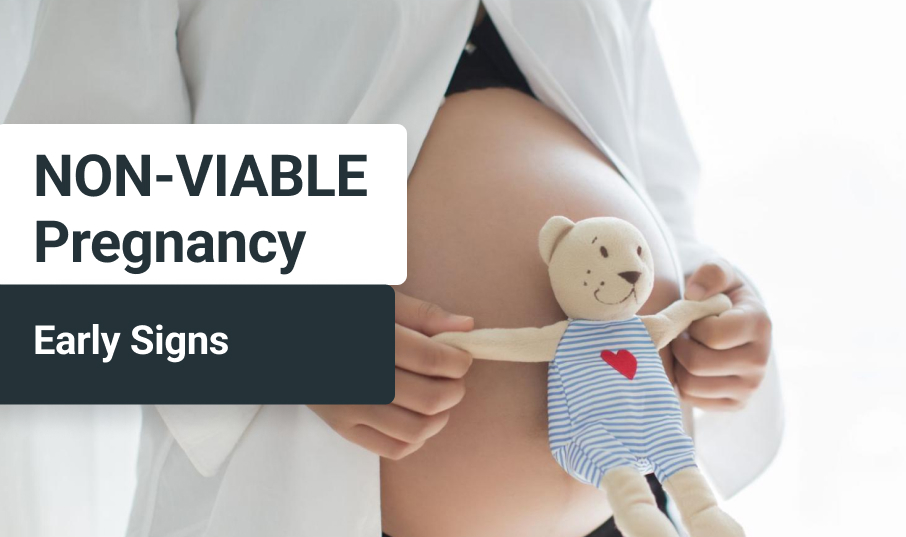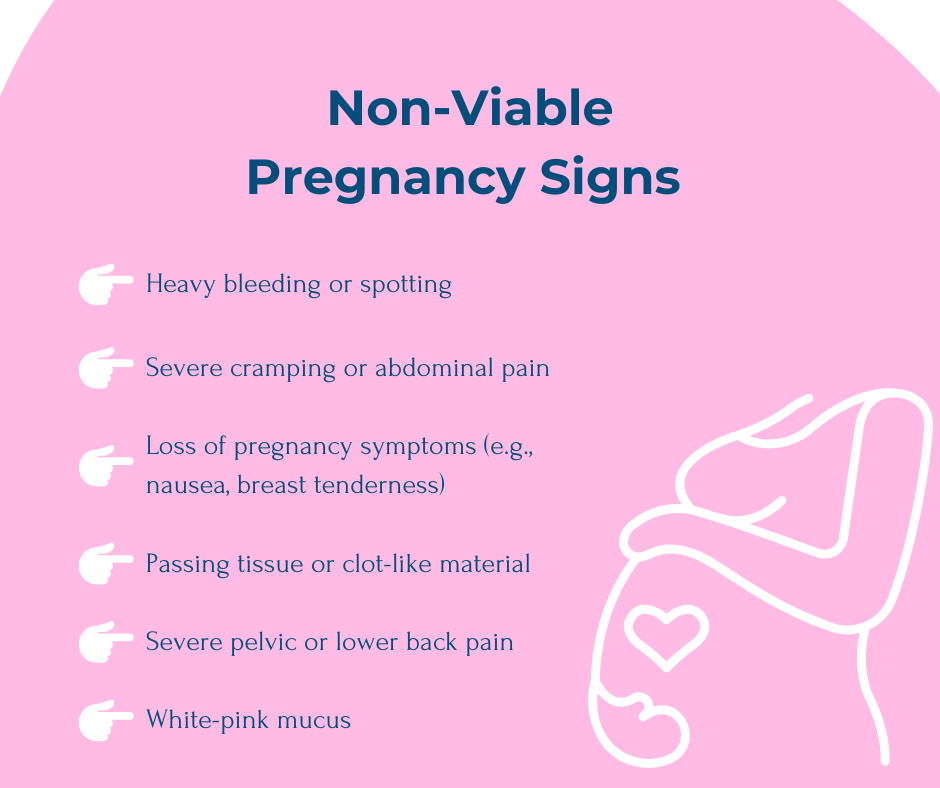What Is a Non-Viable Pregnancy – Meaning, Signs, and Treatment
Pregnancy is an extremely exciting period. However, it can have complications in each of the trimesters. During these months, it is decided whether the pregnancy is viable, i.e., the fetus can grow into a baby and survive the birth. Otherwise, it is considered unviable and ends in miscarriage at an early stage (sometimes even before the loss of menstruation) or abortion.

In this article, we’ll look at what non-viable pregnancy means, what its symptoms are, and how to avoid this pathology.
What Does Non-Viable Pregnancy Mean?
The medical term non-viable pregnancy implies that the fetus cannot grow and develop normally in the womb and outside the uterus. Simply put, there is no chance of giving birth to a live, healthy, and fully developed child. The concept of a non-viable gestation is applied to a variety of cases, including ectopic pregnancies or fetal death with a loss of heartbeat. The pathology occurs in 10% of women. At the same time, 80% of them experience fetal loss during the first trimester, which is considered the most dangerous and vulnerable.
Let’s take a look at what fetal non-viability means at different stages:
| Stage | Non-Viability Meaning |
| Before 6 weeks | At the early stage, fetal non-viability may be indicated by abnormally low or declining Human Chorionic Gonadotropin (hCG) levels. Low hCG shows that the embryo isn’t developing as expected or that implantation has failed. |
| After 6 weeks | Non-viability may be identified through ultrasound findings such as a gestational sac without a visible embryo or a lack of cardiac activity in an embryo larger than 7mm. An absent or irregular heartbeat may indicate a fetal demise. |
| Before 22-24 weeks | Doctors may detect structural abnormalities or growth restrictions in a fetus that are incompatible with survival outside the womb. |
| After 22-24 weeks | Viability improves with modern intervention. However, non-viability may still be an issue if a baby has severe health conditions, such as profound brain abnormalities or extremely low birth weight. |
Non-Viable Pregnancy Signs
Depending on the term, non-viability occurs with various symptoms or without any obvious signs at all. Let’s examine each case in more detail.
First of all, let’s look at chemical pregnancy. It is a miscarriage that occurs up to 5 weeks after conception when the embryo does not take root in the uterus. The loss happens so early that the woman may not even notice she is pregnant. Such a miscarriage is often mistaken for the onset of the period. It should be noted that even in this case, the embryo produces hCG and may cause a false positive test result. The hormone level returns to normal within 2–3 weeks.
If a non-viable gestation manifests itself at a later stage, a woman may experience various symptoms indicating pathologies.
The signs become noticeable after 6 weeks when the embryo has implanted in the uterus.

Here are some of the main symptoms of non-viable pregnancy
- Heavy bleeding or spotting;
- Severe cramping or abdominal pain;
- Loss of gestational symptoms (e.g., nausea, breast tenderness);
- Passing tissue or clot-like material;
- Severe pelvic or lower back pain;
- White-pink mucus.
Remember that the presence of a symptom is not an exact sign of a non-viability and may indicate other pathological conditions. If you feel unwell, contact your doctor to confirm or deny the diagnosis and get the necessary treatment.
How to Diagnose a Non-Viable Pregnancy?
Since a non-viable pregnancy is often asymptomatic or has signals similar to early gestation, this pathology requires diagnosis. Here are two ways doctors identify this condition.
HCG Test
After the implantation, the level of the hormone HCG in the blood doubles every two days. By six weeks, it may reach 32,000! This indicates normal fetal development. Non-viable pregnancy hCG is too low, often below 1,000 mIU/mL. The exact level of the hormone is measured using a blood test.
Non-Viable Pregnancy Ultrasound
The status is determined by an ultrasound examination starting from the 6th week. The doctor checks for the presence of the yolk sac and measures the size of the fetus. The main indicator is the presence of a heartbeat. It allows you to determine whether the fetus is viable and able to grow into a baby.
Non-Viable Pregnancy Reasons & Causes
Doctors do not give an accurate conclusion about what causes early pregnancy loss. It can happen even in a completely healthy woman of childbearing age. At the same time, the next conception can be completely successful and proceed without pathologies. In general, the following factors are the most common causes of failure:
- fetal chromosomal abnormalities;
- old or too young age of the mother;
- previous early gestation;
- drug/alcohol/tobacco addiction of the mother;
- chronic diseases.
A non-viable gestation has several prerequisites. It includes fetal adherence outside the uterus, miscarriage, and other cases. Below, you can explore each of them and see the main signs of the specific condition.
Non-Viable Pregnancy Types and their Diagnostics
| Type of Non-Viability | Description | Symptoms | Diagnostic Methods |
| Chemical Pregnancy | Very early loss, typically occurring before the fifth week. | Light bleeding, often few symptoms due to early occurrence. | Blood tests to see hCG levels (5-50 mIU/mL) |
| Ectopic Pregnancy | Egg implants outside the uterus, often in a fallopian tube. | Sharp or stabbing pain on one side, heavy bleeding, shoulder pain, dizziness, or fainting. | Ultrasound to check for the location of the fetus.HCG is typically, less than 1,000 mIU/mL or slow rise. |
| Molar Pregnancy | Abnormal growth of placental tissue, either partial (some fetal tissue) or complete (no fetus). | Severe nausea and vomiting, rapid uterine growth, high HCG levels, vaginal bleeding. | Ultrasound showing “cluster of grapes” appearance, abnormally high HCG levels (often >100,000 mIU/mL). |
| Blighted Ovum | A fertilized fails to develop into an embryo, leading to an empty gestational sac. | Mild cramping and spotting. | Serial HCG tests show lack of rise. |
| Abnormal Chromosome Count | Genetic anomalies (e.g., trisomies, monosomies) lead to miscarriage, often in the first trimester. | Loss of pregnancy symptoms. | Genetic testing and ultrasound to see structural anomalies. |
| Missed Miscarriage | The embryo or fetus stops developing, but there may be no immediate signs of miscarriage. | Often asymptomatic; may be with slight spotting. | Ultrasound shows no heartbeat. |
Non-Viable Pregnancy Treatment
Unfortunately, there are no methods to save a non-viable gestation. Most often, it ends in a spontaneous miscarriage. In other cases, surgery or medication may be required to remove the remaining fetal tissue from the uterus.
After this procedure, a woman needs to recover, both mentally and physically. We advise you to undergo a thorough examination by a doctor and undergo a course of fertility treatment if necessary. It may include vitamin therapy or more serious medications in severe cases.
Most often, the pathology goes away without affecting fertility. However, there are cases in which the situation is repeated. In this scenario, consider IVF (full or mini cycle). Fertilization will occur in a test tube, and the embryo will be transferred to the uterus for implantation. At the same time, all processes will take place under the strict control of specialists. It reduces the risk of gestation loss and allows you to carry a healthy child. For more difficult situations, we recommend surrogacy.
FAQ
Usually, a non-viable pregnancy passes in 2 weeks and ends naturally by miscarriage. If concomitant diseases or complications are identified during the examination, the doctor may prescribe medications to induce a miscarriage or even surgery to remove the fetus. In this case, the pathological condition ends faster.
In fact, yes. A non-viable gestation ends in a fetal loss in any case. It happens through a natural or artificially induced miscarriage.
No. As of now, there are no treatments for the pathology, so it cannot develop into a normal one and result in the delivery of a baby.
To Sum Up
To summarize, a non-viable pregnancy is a condition in which the fetus cannot develop in and out of the uterus and survive the birth. Unfortunately, it is fatal and ends in miscarriage. It is quite common in early pregnancy and often does not depend on the state of the reproductive system and the woman’s lifestyle. However, you should not despair. Such a case does not automatically doom you to repeat the scenario in subsequent gestation. After recovery, the couple has every chance of having a healthy baby.
If you have experienced several early losses, we recommend considering IVF or surrogacy. The well-tailored treatment makes you realize your dream of completing your family without mental and physical stress. If you have any questions about fertility treatment or would like to find a surrogate mother, don’t hesitate to contact us. We help you cope with your hardships and build a long-awaited and happy family.